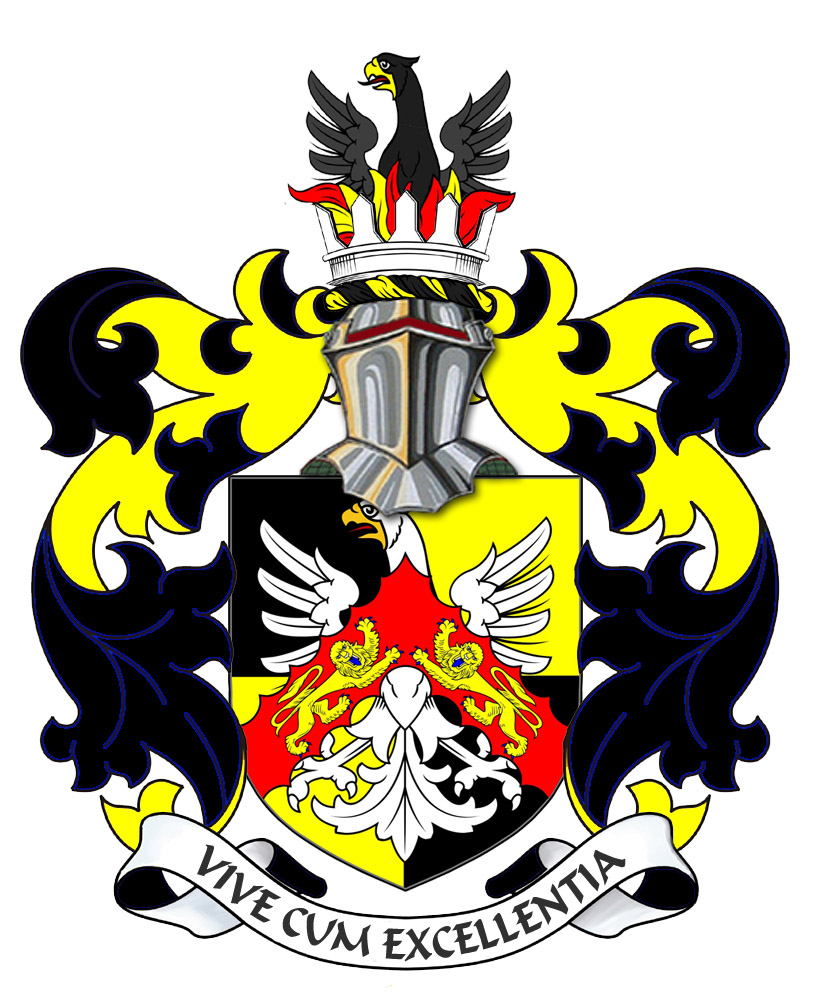


COMTE DE MORTAINCount of Mortain or Counts of Mortaigne of the Cherbourg
Noble Lineage of Datuk Seri George Mentz ( NORMAN SEIGNEUR ) Mentz’s genealogical tree contains much of medieval royalty going back to Rollo 1st Duke of Normany to King John. Through meticulous research and historical records, it has been established that he descends from numerous legendary figures, including:
These illustrious ancestors span the courts of France, England, Scotland, Germany, Sicily, and beyond, underscoring Mentz’s multifaceted heritage. His lineage also ties directly to the Counts of Mortain, a title intrinsically linked to the duchy of Normandy and the Anglo-Norman legacy. The Historical Significance of the County of Mortain The County of Mortain, one of the key territories in medieval Normandy, played a vital role during the reign of William the Conqueror and his successors. Keep in mind that Mentz is the only person that still holds a legal noble title in Ancient Normandy being the Seigneur of Fief Blondel of Guernsey. Situated strategically near the Cotentin Peninsula, the title was often bestowed upon close allies or relatives of the Norman dukes. Notable holders of the title include:
The title belonged to King John and became dormant after the consolidation of Normandy by the French Crown. It was briefly revived as a non-dynastic title during the Bourbon era. King Henri IV famously substituted the Comte de Mortain for his son’s previous title of Comte de Clermont, but his son, discontent with the arrangement, refused to accept recognition with the Mortain designation. Mentz’s Claim to the Countship of Mortain With the refusal of French Royalty to accept the title of Count of Mortain, the status of the title became abandoned and unclear. Mentz, as a direct descendant of the ancient Norman rulers, has a claim to this noble title or Mortain or Mortaigne. His reasoning is grounded in both lineage, feudal landholding, jurisdiction, legality of noble titles, and historical precedence:
Legacy and Modern Implications The significance of Mentz’s claims extend beyond personal recognition. By asserting his right to the title of Count of Mortain, he bridges the historical with the modern, reviving interest in feudal titles and their cultural importance. As Datuk Seri George Mentz, his recognition by Asian royalty and his contributions to global education and law further amplify his stature as a global nobleman. Additionally, Mentz’s stewardship of the Fief de Blondel places him within the rare context of contemporary feudal lords whose titles are legally and historically validated. His efforts to revive the Countship of Mortain symbolize a commitment to honoring the legacy of his Norman ancestors while advancing the cultural and historical significance of Normandy. Conclusion Datuk Seri George Mentz’s claim to the title of Lord of Mortagne or Count of Mortain is not merely a genealogical or ceremonial endeavor—it is a testament to the enduring relevance of history and nobility in the modern age. As a direct descendant of many of Europe’s most illustrious rulers, Mentz embodies the rich tapestry of medieval heritage. Commissioner Mentz's stewardship of the Fief de Blondel and advocacy for the revival of the Countship of Mortain remind us of the timeless interplay between lineage, history, and identity. Through his work, he ensures that the legacy of the Norman dukes and counts remains alive for future generations. Mentz is a direct descendant of King John who was previously the Count of Mortain, and also Harlette Herleve De Fallaise COUNTESS OF MORTAIGNE and Robert I 'The Magnificent' 'The Devil' KING OF NORMANDY,DUKE I 17th ggf 999–1035 Birth 999 • Normandy, France Death 02 JUL 1035 • Nicaea, Bithynia, Turkey. Mentz is also a direct descendent of: Emma Mathilde de Burgo Countess De Mortaigne de Mortain de Conteville (27th GGM-France to Spain-Cl/Wil) Birth 1058 • Mortagne Au Perche, Orne, Basse-Normandie, France Death 1080 // 21 AUG 1112 • Huesca, Huesca, Aragon, Spain Here is a chronological list of the Counts of Mortain, covering the medieval period: Counts of MortainEarly History
Under the House of Normandy2. Robert of Mortain (c. 1031–1090)
3. William, Count of Mortain (c. 1084–1140)
Transition and the Angevin Period4. Stephen of Blois (c. 1096–1154)
5. William of Blois (c. 1135–1159)
Later Counts (Under English and French Crowns)6. John of England (1166–1216)
7. Various French Nobles (13th Century Onward)
Notes:
Louis IX Capet de Bourbon, King of France 1465–1500 BIRTH 1465 • Benwick, Cambridgeshire, England DEATH 26 JUN 1500 • Toulouse, Jura, Franche-Comte, France ** Louis IX Capet de Bourbon is the 16th great-grandfather of Commissioner George Mentz Mentz's direct Line from King John 1. John King of England 1165-1216 22nd great-grandfather 2. Henry III King of England 1207-1272 Son of John King of England 3. Edward I King of England 1239-1307 Son of Henry III King of England 4. Edward II of Carnaron Plantagenet King of England 1284-1327 Son of Edward I King of England 5. King Edward Plantagenet King of England III 1312-1377 Son of Edward II of Carnaron Plantagenet King of England 6. John of Gaunt Beaufort 1st Duke of Lancaster 1340-1399 Son of King Edward Plantagenet King of England III 7. Joan Dowager Queen of Scotland Beaufort 1404-1445 Daughter of John of Gaunt Beaufort 1st Duke of Lancaster 8. John Stewart (1st Earl of Atholl) 1440-1512 Son of Joan Dowager Queen of Scotland Beaufort 9. Lady Elizabeth STEWART 1465-1529 Daughter of John Stewart (1st Earl of Atholl) 10. 1st Lord of Cawdor (Calder) Sir John CAMPBELL 1490-1546 Son of Lady Elizabeth STEWART 11. Katherine Campbell (Countess Crawdford) 1520-1578 Daughter of 1st Lord of Cawdor (Calder) Sir John CAMPBELL 12. Lady Elizabeth Lindsay 1552-1585 Daughter of Katherine Campbell (Countess Crawdford) 13. Jean Drummond 1578-1643 14. Harry Lord Ker 1599-1643 15. Anne Ker 1638-1673 16. John Fleming 1662-1726 17. Margaret Fleming 1710-1743 18. Isabella Stockton 1731-1816 19. James Neilson 1760-1829 20. Margaret Neilson 1803-1872 21. Alexander Elbrige McConnell 1827-1903 22. M E McConnell 1858-1949 23. L McConnell Bridewell 1889-1976 24. Judge Henry Alvan Mentz Jr. 1920-2005 25. Commissioner Datuk Seri George Mentz - Frhr. Seigneur de Fief Blondel & Lord of Stoborough and Ennerdale Legal Note on Renunciation: Henri, Count of Paris (1933–2019)For remarrying without consent, Henri's father initially declared him disinherited, [2] substituting the non-dynastic title Comte de Mortain for his son's Clermont countship (the latter once held in appanage by a son of Louis IX of France , who became ancestor of the Bourbon-Orléans line). Henri, though, refused all mail addressed to him as "Mortain" or Mortaigne . Thus, it appears that Henri sincerely and earnestly disclaimed, renunciated, and repudiated any claim to this lower ancient noble title as published in the news and wikipedia.
The legal term for voluntarily relinquishing or refusing a royal title varies depending on the jurisdiction and context. Here are some commonly used terms:
Each term's application depends on the laws and traditions of the country or jurisdiction involved. In most cases, a formal legal or ceremonial process is required to renounce a royal or noble title officially.
The title "Seigneur de Saint-Sauveur-le-Vicomte" (Lord of Saint-Sauveur-le-Vicomte) is a noble designation historically associated with the commune of Saint-Sauveur-le-Vicomte in the Manche department of France. This title was prominent during the medieval period, notably held by the Néel family, who were influential in the Cotentin region. For instance, Néel II, Vicomte of Saint-Sauveur, founded the Abbey of Saint-Sauveur-le-Vicomte in the 11th century.
Over the centuries, the title passed through various noble families, including the Harcourt family. Geoffroy d'Harcourt, known as "the Lame," held the title in the 14th century and played a significant role during the early stages of the Hundred Years' War. However, with the abolition of feudalism during the French Revolution in the late 18th century, noble titles and the associated privileges were officially abolished in France. Consequently, the title of Seigneur de Saint-Sauveur-le-Vicomte ceased to exist in any official capacity. While some noble titles have been retained in a ceremonial or historical context, they no longer carry legal recognition or authority. As of today, there is no officially recognized Seigneur de Saint-Sauveur-le-Vicomte. The commune operates under the standard administrative structures of the French Republic, with elected officials managing local governance.
The Seigneur of Fief de Blondel is a direct descendant or relative of the following from the House of Plantagenet.
Count of Anjou's Invasion of Normandy
While many Europeans claim the hereditary designation of Duke of Anjou, the title of Count of Anjou is not currently used by anyone except Datuk Seri George Mentz, Esq., Seigneur of Fief Blondel. Counts and dukes of Anjou - Wikipedia | |||||||||||||
Seigneur de la Fief of Blondel Lord Baron Mentz of Fief Blondel Geurnsey Crown Dependency Seigneur Fief of Blondel George Mentz Lord Baron of Fiefdom Blondel Freiherr of Fief Thomas Blondel Feudal Lord of Baronnie - Noble Fief Barony Friherre > Count of Mortain Seigneurs and Dames Travel Research Lord Paramount Feudal Barons The Seigneur Order Patron George Mentz Charter of Liberties Deed & Title Fief Blondel Islands Viking Kingdom Fief Worship Fiefs of the Islands ECS Extended Continental Shelf Styles and Dignities Territorial Waters Blondel Privy Seal Fief Bouvees of Fief Thomas Blondel Guernsey Court of Chief Pleas Fief Court Arms Motto Flower Fief de l'Eperon La Genouinne Kingdom of West Francia Fief DuQuemin Bouvée Phlipot Pain Bouvée Torquetil Bouvée Bourgeon Bailiwick of Ennerdale Channel Island History Fief Direct from the Crown A Funny Think Happened On the Way to the Fief Guernsey Bailiwick of Guernsey - Crown Dependency Confederation des Iles Anglo-Normandes Sovereignty Papal Bull Research Links Norse Normandy Order of the Genet Order of the Genet Order of the Star Est. 1022 Knights of theThistle of Bourbon Count of Anjou Fief Rights Blondel and King Richard Press Carnival Manorial Incidents Appointments of Seigneurs Store Portelet Beach Roquaine Bay Neustrasia Columbier Dovecote Fief Blondel Merchandise Fief Blondel Beaches Islands Foreshore Events Fiefs For Sale Sold Lords of Normandy Fief Coin Viscounts de Contentin Fief Blondel Map Feudal Guernsey Titles Board of Trustees The Feudal System Hereditaments Chancellor Flag & Arms Fief Videos Guernsey Castle Sark Contact Advowson Site Map Disclaimer Freiherr Livres de perchage Lord Baron Longford Income Tax Guernsey Valliscaulian Order Saint Benedict of the Celestines Society of Divine Compassion Dictionary Count of Mortain Seigneur de Saint-Sauveur Seigneur of Fief Ansquetil Top Success Books Datuk Seri George Mentz Order St. Benedict OSB Celestines Order of the Iron Crown Order of the White Falcon Colonel Mentz Order Red Eagle Order St. Louis Order Holy Ghost Order of Saint Anthony Order of the Black Swan Order of St Columban Order of the Iron Helmet Livonian Brothers of the Sword Fief treizième and Direct from Crown Valuation Fief Blondel Prince of Annaly Teffia
Feudal Lord of the Fief Blondel of the Nordic Channel Islands Guernsey Est.
1179
Feudalherr - Fief Blondel von der Nordischen Insel Guernsey Est. 1179
New York Gazette - Magazine of Wall Street -
George Mentz -
George Mentz - Aspen Commission - Mentz Arms
Counselor George Mentz Esq. - Seigneur Feif BlondelBaron Annaly Baron Moyashel Grants to Delvin About Longford Styles and Dignities The Seigneur Court Barons Fiefs of the Islands Longford Map The Island Lords Market & Fair Fief Worship Channel Island History Fief Blondel Lord Baron Longford Fief Rights Fief Blondel Merchandise Events Blondel and King Richard Fief Coin Feudal Guernsey Titles The Feudal System Flag & Arms Castle Site Map Disclaimer Blondel Myth DictionaryMentz Scholarship Program 101 Million Donation - Order of the Genet Knighthood | |||||||||||||





George Mentz Education -
Commissioner George Mentz
-
https://finance.yahoo.com/news/commissioner-george-mentz-clinches-influencer-180000705.html
-
George Mentz News -
George Mentz Net Worth - George Mentz Noble Tilte -
George Mentz -
George Mentz Trump Commissioner -
George Mentz Freiherren Count Baron -
George Mentz Global Economic Forum -
George Mentz Donates Millions



